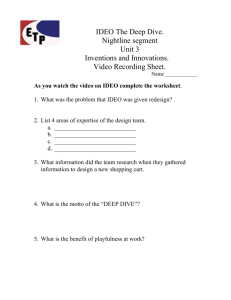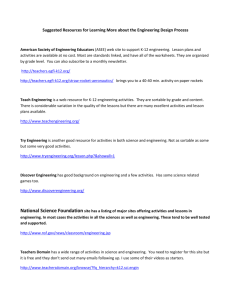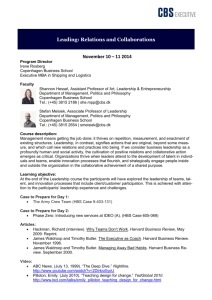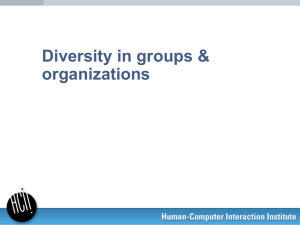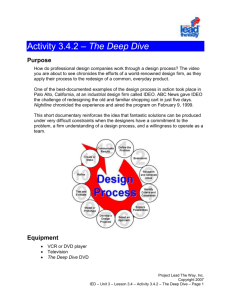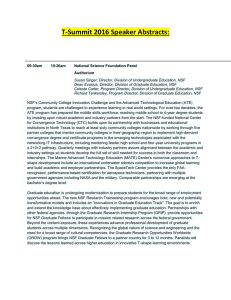KLK Þ K ÞÞK Þ L$ K ÞK KK ÞK > $ KL Þ$ œ
advertisement
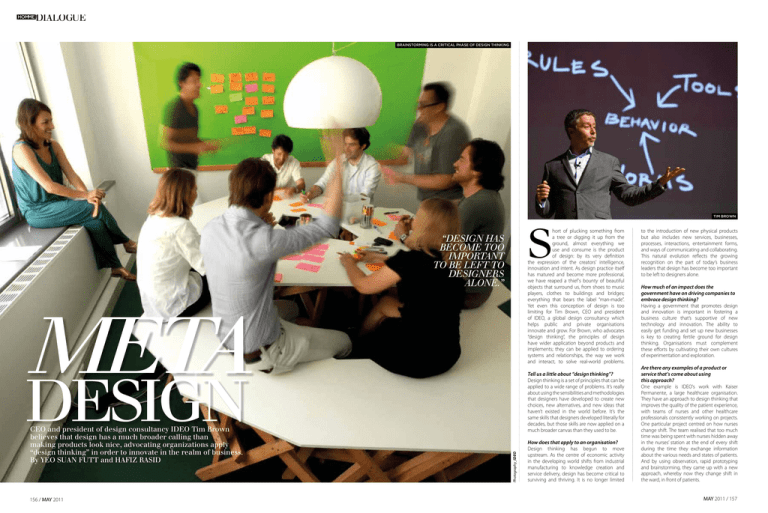
!"#$%&'(
!"##$ !
%&'()*+"&#(),-(*-'-.&(+(.'/-0!'*$-"1-2$*(,)-+!()3(),
+(#-%&"4)
)
hort of plucking something from
a tree or digging it up from the
ground, almost everything we
use and consume is the product
of design: by its very definition
the expression of the creators' intelligence,
innovation and intent. As design practice itself
has matured and become more professional,
we have reaped a thief's bounty of beautiful
objects that surround us, from shoes to music
players, clothes to buildings and bridges;
everything that bears the label “man-made”.
Yet even this conception of design is too
limiting for Tim Brown, CEO and president
of IDEO, a global design consultancy which
helps public and private organisations
innovate and grow. For Brown, who advocates
“design thinking”, the principles of design
have wider application beyond products and
implements; they can be applied to ordering
systems and relationships, the way we work
and interact, to solve real-world problems.
!"#$%&'()*$(
+#,-.#(/--(
%.0-1/*'/(
/-(+#(2#3/(/-(
"#$%&'#1$(
*2-'#45
!"#$
6"E5MH
156 / MAY 2011
Photography_IDEO
!"#$%&'$()*+,'*&-$./$'*+,0&$1.&+23-%&14$56"#$7,8$9).:&$
;*3,*<*+$-=%-$'*+,0&$=%+$%$821=$;).%'*)$1%33,&0$-=%&$$
8%>,&0$().'21-+$3..>$&,1*?$%'<.1%-,&0$.)0%&,@%-,.&+$%((34$$
A'*+,0&$-=,&>,&0B$,&$.)'*)$-.$,&&.<%-*$,&$-=*$)*%38$./$;2+,&*++C
94$D"#$EFGH$IF77$%&'$JGI5K$LGE56
Tell us a little about “design thinking”?
Design thinking is a set of principles that can be
applied to a wide range of problems. It’s really
about using the sensibilities and methodologies
that designers have developed to create new
choices, new alternatives, and new ideas that
haven’t existed in the world before. It’s the
same skills that designers developed literally for
decades, but those skills are now applied on a
much broader canvas than they used to be.
How does that apply to an organisation?
Design thinking has begun to move
upstream. As the centre of economic activity
in the developing world shifts from industrial
manufacturing to knowledge creation and
service delivery, design has become critical to
surviving and thriving. It is no longer limited
to the introduction of new physical products
but also includes new services, businesses,
processes, interactions, entertainment forms,
and ways of communicating and collaborating.
This natural evolution reflects the growing
recognition on the part of today’s business
leaders that design has become too important
to be left to designers alone.
How much of an impact does the
government have on driving companies to
embrace design thinking?
Having a government that promotes design
and innovation is important in fostering a
business culture that’s supportive of new
technology and innovation. The ability to
easily get funding and set up new businesses
is key to creating fertile ground for design
thinking. Organisations must complement
these efforts by cultivating their own cultures
of experimentation and exploration. Are there any examples of a product or
service that’s come about using
this approach?
One example is IDEO's work with Kaiser
Permanente, a large healthcare organisation.
They have an approach to design thinking that
improves the quality of the patient experience,
with teams of nurses and other healthcare
professionals consistently working on projects.
One particular project centred on how nurses
change shift. The team realised that too much
time was being spent with nurses hidden away
in the nurses’ station at the end of every shift
during the time they exchange information
about the various needs and states of patients.
And by using observation, rapid prototyping
and brainstorming, they came up with a new
approach, whereby now they change shift in
the ward, in front of patients.
MAY 2011 / 157
!"#$%&'(
!"##$ !
!#60#1%.#'/*/%-'7(
#602-1*/%-'7(*'"(
*'(#'/)8$%*$.(
3-1('#9(%"#*$(*1#(
:#;4(%/<$(%.0-1/*'/(
/-(.*:#(%"#*$(
/*'&%+2#(*$($--'(*$(
0-$$%+2#7(/)1-8&)(
$/-1;/#22%'&(
/--2$7($:#/,)#$7(-1(
1-8&)(01-/-/;0#$4(
*'"(/)#'(;-8(/#$/(
/)-$#(%"#*$7(*'"(
&#/(1%"(-3(/)#.(%3(
/)#;("-'</(9-1:45(
You identified T-shaped people as the
backbone of IDEO’s collaborative culture.
What's a T-shaped person?
T-shaped people are individuals with strengths
in two dimensions. On the vertical axis, every
member of the team needs to possess a depth
of skill that allows him or her to make tangible
contributions to the outcome. They also need to
be able to work well in the messy environments
required to solve complex problems. Design
thinkers cross the “T”: They may be electrical
engineers who studied theology, or sociologists
with MBAs. In addition to having a depth and
breadth of skills, T-shaped people have a
collaborative disposition that allows them to
work across disciplines with others who have
complementary areas of expertise.
How do you identify a T-shaped person?
You can’t always judge by résumés. Hiring
T-shaped people is more complex than hiring
people with just one deep area of expertise.
Usually, you can tell a T-shaped person right
away when meeting them. You can see it in
terms of how they talk about the people they
collaborate with – if someone is talking about
the projects they’ve worked on, and they’re
only mentioning their contributions, that’s
a problem. We look for people who have
diversity in experience, background, interest,
and who will talk about how other people have
helped them to do what they’ve done.
Finally, the more complex the job you’re
hiring for, the more contact you need to
have with a person before bringing them on.
We don’t rush the process, and get to know
potential employees before hiring.
05++(),-(2$'*-+",$+!$&-()-'-*6)+!$*(*-*$**(")
1$$2%'.3-(*-*+52($2-')2-(2$'*-&$1()$2-()-+!$-0&"+"+60(),-0!'*$-"1-2$*(,)-+!()3(),
"0$)-(2$"
!)%1%'&(/=$)*0#"(0#-02#(%$(.-1#(
,-.02#6(/)*'()%1%'&(0#-02#(9%/)((
>8$/(-'#("##0(*1#*(-3(#60#1/%$#45(
They’ve developed a simple software tool
to help them do it, and they’ve brought the
time in between shifts that they’re away from
the patients from an average of 40 minutes
down to 12 minutes. And that has increased the
confidence of the patients because the patients
can watch and listen to the information being
translated and transferred, and they can also
participate and contribute in the exchange if
they want.
0&"+"+60(),
158 / MAY 2011
How does a company create a culture
where ideas grow organically?
You need to create a culture where respect
is given to the idea, rather than the person
suggesting it. Experimentation, exploration,
and an enthusiasm for new ideas are key. It’s
important to make ideas tangible as soon as
possible, through storytelling tools, sketches,
or rough prototypes. And then you test those
ideas, and get rid of them if they don’t work.
There’s a difference between putting away
ideas that don’t work and shutting down ideas
before they have a chance to become real.
If ideas are shut down, or only happen in a
designated innovation time or space, you’re
not tapping into the innovation potential of
an organisation.
How does a global company that is spread
out geographically sustain a consistently
innovative culture?
We have eight offices around the world and are
running projects in many more places. As we’ve
grown, we’ve found that we need to adapt
to the local culture and practices, while also
keeping true to our core values and methods
that we believe have the ability to create
real impact.
We have learnt that it is valuable to move
people around the company so they benefit
from the exposure to different countries and
cultures. This helps maintain the IDEO culture
as we grow around the world.
What are some companies you have seen
that understand the value of collaboration
and the notion of T-shaped behaviour?
Kaiser, which was mentioned earlier, has
assembled a great team of T-shaped design
thinkers to be part of its innovation consulting
team. Many of them come from nursing
backgrounds. Other great examples include
the Aravind Eye Hospital in Madurai, India and
sportswear company Nike.
What were the most important leadership
lessons you learned, and how did you
learn them?
Perhaps the most important lesson was to
realise that I could treat leadership as a design
problem. When I took over leading offices
at IDEO and eventually the company when
I became CEO, I felt I was unqualified as a
leader because I had no management training.
I eventually came to realise that although
I may not be skilful in reading spreadsheets
or knowledgeable in accounting or finance,
my design training does give me other useful
leadership skills. I know how to identify needs,
explore potential solutions and present those
solutions in a form that others can understand.
These are all tremendously useful when it
comes to driving innovation or change within
an organisation.
MAY 2011 / 159
